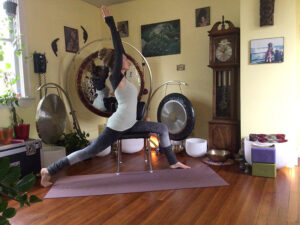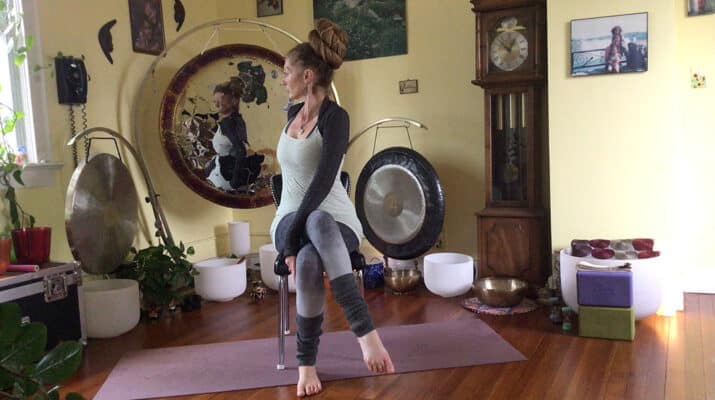Although mostly a seated activity, chair yoga promotes good health
By Deborah Jeanne Sergeant

For people with limited mobility, practicing yoga seems unattainable. But chair yoga may offer an entry point.
Chair yoga is an informal term that may refer to practicing yoga, including some modified poses, entirely while seated or it can also refer to using a chair more like a yoga prop for people capable of standing but who need support to augment their balance.
“Chair yoga is an inclusive practice, unlike the traditional yoga you have to do poses standing or on the floor,” said Brian De Luca, physical therapist and strength coach with UBMD Orthopedics and Sports Medicine in Buffalo. “The chair is a way to have a stable base where you can go through modified poses without the risk of falling. At a certain age, you’re not going to be able to get on and off the ground as easily. Chair yoga is a ramp up for traditional yoga.”
He also views chair yoga a helpful starting point for people who are recovering from injuries to safely practice yoga and later transition into more traditional yoga movements as they’re able. The point is that patients are moving and De Luca views “movement is medicine.”
Rolling out a yoga mat in one’s cubicle isn’t practical, but De Luca said that learning a few chair yoga moves can help desk-based workers breathe deeper, relax, stretch and strengthen.
Chair yoga can also help people improve focus.
Nancy Shea, certified Pilates instructor, certified yoga instructor and co-owner of Balance Pilates in Williamsville, said that with chair yoga, participants are in a static position, yet moving their arms.
“A lot of people when I studied it notice it’s difficult to keep yourself still,” Shea said. “For me, it’s much more mental. When you’re thinking about the body, chair yoga puts you in a place where you are sitting still and everything on the body has to disassociate from your center, so your arms come outside of your body but you don’t want to move. You’re in a static place, but if you’re moving your arms up and down, how can you move them without moving your central body?”
Chair yoga can make the practice accessible to older adults.
Elizabeth Hornak, certified yoga instructor at JCC Rochester, leads gentle yoga classes, mostly attracting older participants.
“As we age, our muscles will contract,” Hornak said. “We’re looking to lengthen and strengthen. Breath is a huge part of yoga. It’s incredibly nourishing and healing for tissues.”
Hunching over decreases lung activity, but Hornak said that yoga poses can help people learn to breathe more deeply.
She views chair yoga as a way to help keep participants safer, more active and able to explore their potential. Even if a pose isn’t perfect or traditional, it keeps participants moving, which provides much benefit.
“One of the ‘foundational’ moves is cat cow,” Hornak said. “You’re on all fours and as you breathe, you bring your spine into flexion and extension. You can do cat cow seating, standing or on all fours. It’s an incredibly versatile pose.”

